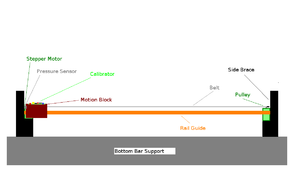Difference between revisions of "Calibration Device for Scintillators"
Jump to navigation
Jump to search
| Line 34: | Line 34: | ||
==== Motor ==== | ==== Motor ==== | ||
*Need to locate a stepper motor to attach to one end of the pulley belt system | *Need to locate a stepper motor to attach to one end of the pulley belt system | ||
| + | |||
| + | ==To Do== | ||
| + | *Tightening Mechanism for belt | ||
| + | *Pin for gear | ||
| + | *Find gear diameters | ||
| + | *Mount for Pin | ||
| + | *Motor Mount | ||
| + | *Find angular step size | ||
| + | *Find movement (x direction) step size | ||
==Possible Resources== | ==Possible Resources== | ||
Revision as of 20:11, 24 January 2011
- The objective is to create a linear motion device that will calibrate a set array of scintillators using light pulses
Ideas
- Printer disassembly and take-over of printer head linear motion through use of parallel port programming with C
- Worm gear connected to DC motor with micro controller set up
- Linear Rail system
- Stepper Motor Belt System
Printer's Linear Motion
- Disassembled printer casing
- Installed cygwin on computer for C interface and read up on programming language C
- Investigated Computer Numerical Control but found it was not useful for this application
- Investigated serial port programming and the use of Printer Control Language on an HP printer click here for documentation on PCL
Parallel Port Programming
- Interfacing directly to the printer proved very challenging . For help, click here.
- Unsuccessfully accessed printer
Worm Gear
- Spinning a long grooved metal cylinder gear requires a lot of torque
- Minimal support for head motion
- DC motor with time steps is not as effective as stepper motor
Rail System
- Has internal motion control
- very costly
- possibly too heavy duty for this application
Belt System
- Stepper motor with micro controller stands stationary on one end and calibration device would be connected to a slide rail system for stability
 Clamping Plate Setup http://www.polytechdesign.com/images/gears_01.gif
Clamping Plate Setup http://www.polytechdesign.com/images/gears_01.gif - We need to find something that is low cost but is accurate enough to be stopped at each fiber array block. This would call for a low pitch. One example I've found is as low as 8mm pitch with 200 teeth making a 1.6 meter timing belt. Because the intended light source for calibration is most likely going to have a wide range, 8mm is a fair sized step as the scintillators are 2mm each but grouped in blocks.
- For support: Overhead Enclosed-Track Conveyor Bracket, linear guide rail
Motor
- Need to locate a stepper motor to attach to one end of the pulley belt system
To Do
- Tightening Mechanism for belt
- Pin for gear
- Find gear diameters
- Mount for Pin
- Motor Mount
- Find angular step size
- Find movement (x direction) step size
